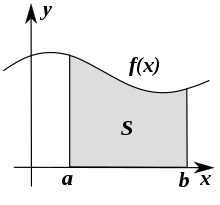
Back تكامل ريمان Arabic Riman inteqralı Azerbaijani Інтэграл Рымана Byelorussian Integral de Riemann Catalan تەواوکاریی ڕیمان CKB Riemannův integrál Czech Риман интегралĕ CV Riemannsches Integral German Rimana integralo Esperanto Integral de Riemann Spanish



| Part of a series of articles about |
| Calculus |
|---|
In the branch of mathematics known as real analysis, the Riemann integral, created by Bernhard Riemann, was the first rigorous definition of the integral of a function on an interval. It was presented to the faculty at the University of Göttingen in 1854, but not published in a journal until 1868.[1] For many functions and practical applications, the Riemann integral can be evaluated by the fundamental theorem of calculus or approximated by numerical integration, or simulated using Monte Carlo integration.
- ^ The Riemann integral was introduced in Bernhard Riemann's paper "Über die Darstellbarkeit einer Function durch eine trigonometrische Reihe" (On the representability of a function by a trigonometric series; i.e., when can a function be represented by a trigonometric series). This paper was submitted to the University of Göttingen in 1854 as Riemann's Habilitationsschrift (qualification to become an instructor). It was published in 1868 in Abhandlungen der Königlichen Gesellschaft der Wissenschaften zu Göttingen (Proceedings of the Royal Philosophical Society at Göttingen), vol. 13, pages 87-132. (Available online here.) For Riemann's definition of his integral, see section 4, "Über den Begriff eines bestimmten Integrals und den Umfang seiner Gültigkeit" (On the concept of a definite integral and the extent of its validity), pages 101–103.
© MMXXIII Rich X Search. We shall prevail. All rights reserved. Rich X Search
